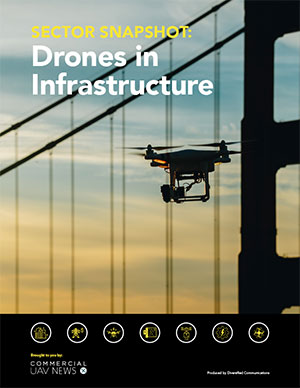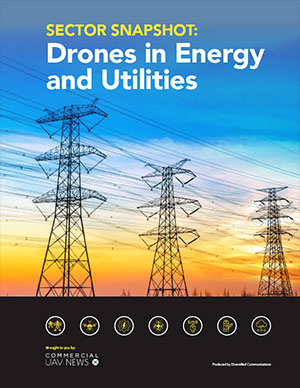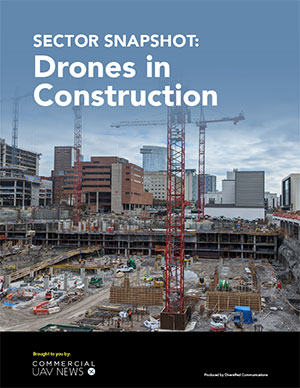“Detecting wildfires within minutes is a technological triumph—but if aerial suppression is delayed or interrupted due to visibility constraints, the net gain is lost. Timeliness and sustainment must extend from detection to response.”
Imagine calling 911 to report a fire in your home and being told the engines can’t roll until the smoke clears and visual conditions are restored. That’s unthinkable for structure fires. Yet every wildfire season, communities are told exactly that: aerial suppression can’t launch because visibility is degraded by smoke or darkness. We’ve normalized a 95‑year gap in aerial firefighting — since the first water drops in 1930 — that keeps our most critical airborne support on the sidelines for most of each 24‑hour operational period.1
Drones and optionally piloted aircraft can end that gap. We simply must decide that our firefighters and the communities they protect deserve access to 24/7 initial and extended attack aerial support and commit to delivering this capability.

The Stakes: A National Emergency We Still Fight From The Air on an Eight‑Hour Clock
Wildfire is an undeclared national emergency, measured not just in acres and headlines but in dollars, health, and hard‑to‑regain community stability.2 Federal suppression spending now regularly tops billions each year and still covers only a fraction of the total bill. Broader losses — property, infrastructure, lost income, ecosystem damage — are estimated in the hundreds of billions annually. Smoke’s health toll stretches thousands of miles, pushing PM2.5 particulates into city lungs far from any flame front and contributing to respiratory and cardiovascular disease, adverse birth outcomes, and increased mortality. 3 4 This isn’t a Western problem or a seasonal inconvenience; it’s a national, year‑round public‑health and economic blow.5
- Scale: Annual total wildfire costs have been estimated between $394–$893 billion in the U.S., with suppression budgets covering only reactive firefighting — not the vast downstream damages.6
- Health: Long‑range smoke exposure imposes widespread harm and long‑term medical costs, compounding community and economic losses.7
- Reliance on aviation: Ground crews ultimately put fires out — but terrain, distance, and access delay them, right when minutes matter. Aviation exists to buy that time and shape the fight. We count on it — until we don’t.
Wildland firefighting strategy and resource use are founded on a few proven principles. Foremost among them is that every fire starts small, and the time of response can be decisive.8 Rapid suppression lowers total costs, prevents small ignitions from becoming large, destructive events, and backs the ground crews who ultimately contain and extinguish fires.
However, initial ground response is often slowed by distance, rugged terrain, and sparse road access, giving wildfires time to run. As a result, aviation has become indispensable, quickly bringing capabilities that ground crews alone are often challenged to provide. 9 10 From 2011–2021, the U.S. Forest Service (USFS) and the Department of the Interior (DOI) awarded an average of 148 aviation contracts each year, totaling $1.2B annually.11 Demand is rising as well; between 2012 and 2018, the USFS reported the average yearly number of retardant drops—and total gallons used—increased by 66 percent over the prior decade.12

Let this reality sink in. If a wildfire starts at night near your community, somewhere in the U.S., there’s a high likelihood that aerial suppression aircraft won’t be attacking it until morning. This gives the fire uncontested hours to grow and spread. If the ignition event near your community grows into a wildfire that requires extended attack support, responding aircraft will be limited by both night and daytime degraded visual environments that will suspend their suppression and logistics support. We would never tolerate a structure fire response that goes dark from dusk to late morning. Yet, in wildland fire, morning smoke and nightfall routinely ground crewed aircraft. This creates a broken chain: detection without dependable, continuous response.
The 95‑Year Gap: Detection Advances, Response Stuck in Clear‑Air Hours
We’ve poured significant resources into faster, smarter detection: satellites, manned and unmanned surveillance, AI‑assisted camera networks, mapping, and predictive analytics. Recent federal direction has pushed even further — calling for comprehensive technology roadmaps, data sharing, and state and local readiness.14 The Restoring Commonsense to Wildfire Prevention and Response Executive Order represents the most recent example.15 Timely detection is certainly important. But it isn’t sufficient if we can’t act through smoke and darkness when fires today often grow, uncontested from the air.
Two facts define the current mismatch:
- Fires don’t respect flight hours: In a DOI analysis of 2015–2017 wildfire starts, nearly 20% of them ignited outside conventional flight operation hours.16 Of those off‑hours starts, two‑thirds were discovered between end of flight ops and midnight — prime time for those wildfires to grow in acres and run for miles without aerial pressure.
- We miss the best window: On large fires that demand extended attack, morning smoke often delays crewed launches until late morning or afternoon. In 2024, more than 80 percent of retardant flights departed after noon (Figure 2).17 That cedes both the morning and nightly periods — often cooler, calmer, and more humid — when suppression can be most effective.

We also know the cost pattern is asymmetric: roughly 98 percent of ignitions are contained within 24 hours; the remaining two percent consume more than 80 percent of suppression costs.18 19 20 We don’t yet know exactly what share of those costly fires began in off‑hours, but the correlation is hard to ignore: the fire compounding we fear tends to happen when our heaviest tools are grounded.
Aviation became indispensable because it buys time. But under smoke and darkness, the tool we need most has been severely constrained for the past 95 years.
Why Night Vision Won’t Close the Gap
Night vision devices (NVDs) have helped some agencies extend operations at night. They deserve credit — but they aren’t a complete or scalable solution to DVE (degraded visual environments). As a former NVD-qualified Navy fighter pilot, squadron commander, and later as DOI’s Director of Aviation, I’ve personally experienced challenges associated with NVDs, such as:

- Safety and efficacy limits: Heavy smoke, blowing ash, bright flame, and low‑level turbulence degrade NVD effectiveness. In 2021, an air tanker pilot was killed testing NVD technology on a wildfire.21 Daytime DVEs are altogether outside NVD’s capability.
- Cost and proficiency: Outfitting fleets, training pilots, and sustaining currency is expensive. A 2019 DOI information paper prepared for the Secretary of the Interior calculated that the initial outfitting and training cost of an NVD-capable Type II helicopter and crew would exceed $200,000. The cost to maintain minimum NVD currency requires another $6,000 per pilot per year. Due to their initial and recurring costs, safety concerns, and limited utility, the number of NVD‑capable aircraft and aircrew remains a sliver of the national aerial firefighting fleet.
- Mission coverage: While NVDs can be useful in initial attack in combating wildfire ignitions outside traditional aerial firefighting coverage hours, they become increasingly ineffective during developed wildfires where accumulating smoke creates regular day DVEs that routinely last until late morning/early afternoon and have even extended for days. NVDs don’t work at all in the daytime. Even where NVDs help, it doesn’t address some of today’s key mission gaps.
Despite their decades-long use in aviation, Night Vision Devices (NVDs) constitute less than 10% of all aerial firefighting aircraft due to the above factors. NVDs are a valuable bridge — not a highway. We need an all‑conditions aerial system that scales across missions, terrain, and the operational tempo of large incidents.

The Promise of Small UAS, Large Drones, and Optionally Piloted Aircraft
Small and large uncrewed aircraft systems (UAS) and optionally piloted aircraft (OPA) are already proving they can operate safely and effectively through smoke and darkness. The technology exists. The use cases are compelling.
Small UAS
For over a decade, small UAS (sUAS) have been routinely operating over wildfires, providing critical support:22 23
- Persistent Intelligence and Overwatch: sUAS with IR sensors have repeatedly detected unseen spot fires and guided crews to them in nighttime DVEs — preventing escapes behind lines that would otherwise go undetected.
- Mapping in the worst air: UAS can fly above toxic layers and below overcasts to build heat maps and track fire spread when crewed assets are grounded.
- 24/7 situational awareness: Continuous sensing closes the information gap that typically reopens after evening stand‑down — unbroken coverage can be achieved today by sequencing flights of multiple sUAS or leveraging those with longer endurance.
- Aerial Ignition: sUAS equipped with “dragon egg” dispenser payloads are used in prescribed burn and night burnout aerial ignition operations, providing an alternative to traditional methods with improvements in safety and operational costs.24 25 26 27
Notable Early Examples of Proven Performance:
- During the August 2017 Umpqua North Complex Fire, persistent day DVE conditions grounded traditional aircraft. Using its onboard infrared sensor to safely fly in this thick smoke, a DOI-operated drone detected a previously undiscovered spot fire across containment lines. The DOI pilot was then able to successfully direct crews to the fire, who extinguished it, saving $50M in power plant infrastructure. 28 29
- During the August 2018 Taylor Creek Fire, a DOI contracted ScanEagle operating at night discovered a nearly invisible 1×1 foot spot fire beyond the line and successfully guided crews through the dense forest to its location, where they extinguished it — the kind of targets most likely to become tomorrow’s blowups if they’re missed.30
Large Drones
In the future, large drones could serve as the Hotshots’ organic air wing—flying precision spot-drops to cool flanks, conducting aerial burnout operations, hoisting hose packs and tool caches into rough country, relaying comms, and providing thermal overwatch that persists after dark or in smoke, all without waiting on a distant tanker or helibase. The pace to that future hinges on competing factors. Until the FAA’s recently released BVLOS NPRM, there wasn’t a scalable regulatory path for routine commercial BVLOS or for streamlined airworthiness of heavier uncrewed aircraft. The proposal outlines performance-based operations, permits, certificates, ADSP-supported separation, and an acceptance process for aircraft up to 1,320 lbs. that could finally unlock meaningful supply and mission fit.31
The recent Memorandum of Understanding (MOU) between the Oregon Department of Aviation (ODAV) and Yamaha Motor Corporation, U.S.A., to assess the potential of Yamaha’s FAZER SAR unmanned helicopter in wildfire mitigation and suppression efforts is a positive development.32 It also serves as a testament to the visionary and innovative spirit that increasingly emanates from state aviation and wildfire agencies.

Optionally Piloted Aircraft (OPA)
Optionally piloted aircraft (OPA)—crewed airplanes or helicopters adapted to fly with or without a pilot—trace their lineage to World War II conversion efforts such as Operation Aphrodite and the TDR-1 assault drone. Since then, they have become integral to defense as full-scale aerial targets (e.g., QF-16) and versatile flight test workhorses for exploring new autonomy and control laws. In modern conflicts, the USMC’s K-MAX optionally piloted helicopter (OPH) demonstrated the value of this concept in Afghanistan. It successfully flew fully unmanned resupply missions, transporting millions of pounds of cargo and eliminating the need for risky ground convoys. OPAs, which start as certified, crewed aircraft, inherit safety and security advantages over clean-sheet UAS.
These advantages include larger airframes that are easier to visually acquire and electronically surveil, redundant, fail-tolerant flight-critical systems, standard transponders/ADS B for electronic identification, secure, military-grade command-and-control links, proven avionics and flight software, and the ultimate fallback—reverting to a pilot onboard when the mission or airspace demands it. Moreover, as a 2018 DOI primer on OPA explains, since they can be flown remotely or with the pilot in the cockpit, they don’t threaten the jobs of current aerial firefighting pilots and allow for easy repositioning to the next wildfire. Additionally, with the ability to remotely fly a traditionally piloted aircraft, why would you expose pilots to the known hazards and additional risks of night flying under NVDs when this alternative exists and supports daytime operations with obscured visibility?
Suppression
- Direct water drops: OPH can execute precise water dipping and delivery, including repetitive cycles through smoke when crewed low‑level flight is unsafe.
- Night and morning advantage: Cooler temperatures, calmer winds, and higher RH make nighttime and early morning drops more effective — the very periods now uncovered by crewed fleets.
- Safer, simpler problem for ground firefighters: By extending aerial suppression into the 16 hours outside traditional flight windows, OPH can deliver precise water drops that cool fuels, slow fire spread, and reduce intensity before ground crews arrive—making the fire a safer, less aggressive, and more manageable problem. Their ability to operate without risking a pilot in low‑visibility or night conditions means hazards are mitigated while critical suppression continues uninterrupted.
Logistics and emergency support
- High‑tempo resupply: OPH with carousel rigs can self‑fly multiple loads to GPS‑designated drop points on a single sortie — sustaining crews when roads are unavailable and traditional aircraft are grounded due to smoke.
- Medical and extraction support: While policy and procedures must lead, remotely piloted aircraft can stand ready for emergency extraction or medical delivery when weather or smoke shut down crewed options.
Proven Capability, Demonstrated Over a Decade Ago, With Renewed Interest Today:
- In 2014 and 2015, DOI and industry partnered to conduct multiple wildfire‑representative OPH flight demonstrations, validating remotely piloted operations and precise autonomous dipping, suppressant drops, and logistics delivery.33 34
- In 2024, an autonomous Black Hawk demonstration showcased precision firefighting operations without onboard crew.35 36
- On July 31, 2025 the Defense Advanced Research Projects Agency (DARPA) and Texas A&M announced a partnership to continue advancing the use of autonomous helicopters in aerial firefighting missions.37
- Companies working in this space today include: Lockheed Martin, Rain, Rotor, Skyryse.

Integration authority we already have
Why We Haven’t Done it Yet
This isn’t a technology problem. It’s a system problem. We’ve run the play in parts, but not at scale.
- Unfunded mandates: Congress has periodically directed agencies to explore or deploy uncrewed capabilities. However, these directives stall due to competing priorities and a lack of dedicated funding. For instance, the Dingell Act of 2019 mandated the Department of the Interior (DOI) to establish a research, development, and testing program that included optionally piloted aircraft as part of its wildfire technology modernization section. Despite this directive, DOI failed to comply with it due to the absence of congressional funding.40
- Airspace management stuck in analog: Our wildfire airspace system remains manual, radio‑centric, and geospatially improvised — designed for line‑of‑sight coordination in clear air. It doesn’t natively support mixed crewed/uncrewed operations scaled across a complex incident in DVE.
- Cultural friction: Pilots and firefighters rightly prize safety. Introducing new aircraft types, autonomy modes, and comms pathways into an already high‑risk environment triggers understandable caution. However, without repeatable demonstrations, transparent risk frameworks, and experienced and visionary leadership, caution becomes a veto.
- Historical biases: For decades, some ground firefighters have dismissed unaided aerial drops as “wasted water” unless crews are already in place to tie in and coordinate. However, the reality is that well-placed water or retardant can immediately cool fuels, knock down flame lengths, slow spread, and set conditions, buying time and making the eventual ground attack safer and simpler when crews arrive. This is consistent with other high-risk domains: militaries routinely use close air support and shaping fires before troops close, degrading the threat and reducing the complexity of the fight. Modern structural firefighting also embraces transitional attack, where exterior water application rapidly reduces interior temperatures and improves survivability before entry. This proves that cooling first, from the safest position, is not only effective but also smart. The lesson is clear: aerial water is a condition setter, not a standalone solution—and that’s precisely why it matters.
- Procurement and certification drag: Optionally piloted configurations, UAS payloads, and autonomy stacks cross certification lines. Programs that don’t tie directly to near‑term, funded operations and “look different” get deprioritized when budgets tighten.
- Detection overshadowed response: Investments have favored sensing — a politically safe, tech‑forward story — without equal commitment to the messier work of changing how we respond better to wildfires under smoke and darkness.41 42
We’ve proven the pieces: night overwatch that prevents spot‑fire escapes, OPA precision drops and multi‑load logistics in representative scenarios, autonomous heavy‑lift demonstrations. What we haven’t done is to complete the fielding of a sustained, integrated, 24/7 aerial response system designed to operate when crewed aviation cannot.
The Return on Investment: Small Percentage, Outsized Impact
Extended attack is where money goes to burn. Over the past decade, annual federal suppression costs have averaged roughly $2.7 billion, with more than 80% spent on the 2% of fires that escape initial attack. 43 44 That’s the target: the small fraction of incidents that grow during the very hours traditional aerial firefighting aircraft are typically grounded.
- Coverage multiplier: Moving from roughly 8 usable flight hours to 24/7 coverage is a 3X increase in available aerial support time. Not every hour will be equally productive in DVE, and water drops differ from retardant tactics — but even conservative gains matter.
- Conservative case: In 2024, nearly 9M acres burned in the U.S., consuming over $3B in just suppression costs.45 Assume this 200% increase in aerial support time only delivers a 10% reduction in containment time and suppression cost on average because DVE operations are slower, more water‑centric, and more decoupled from ground line construction. Applied against the extended‑attack cohort, that’s a meaningful annual savings — and, more importantly, fewer big fires. 46
- Compounding benefits: Less area burned lowers costs beyond suppression — preparedness, emergency stabilization, burned‑area rehab, infrastructure repair, health impacts, and economic disruption. Each marginal hour we shift from “fire grows uncontested” to “fire meets water” bends multiple cost curves at once.
The point isn’t precision math; it’s leverage. Targeting the off‑hours where wildfire growth has historically gone uncontested with effective tools that can fly then — and do so safely — is the highest‑ROI move left on the board.
What “Closing the Gap” Looks Like in Practice
Here’s what it would take to turn proven demonstrations into sustained capability.
- Fund an operational pilot at scale
- Objective: Stand up congressionally funded, multi‑year, multi‑region deployments that deliver 24/7 intelligence, suppression, and logistics under real incident tempo. As presented to the White House Office of Science and Technology Policy (OSTP) in July 2018, the estimated cost for integrating OPA technology in wildland fire was $10 million. This figure is relatively small, considering the substantial potential return on investment that could be realized by tripling the aerial suppression and logistics coverage hours.47
- Scope: Mix of sUAS for overwatch and mapping, large drones and OPA for water and logistics, pre‑positioned by risk and season.
- Modernize wildfire airspace management
- Objective: Move from radio‑only, manual deconfliction to a digital, geospatially aware common operating picture with a digitally-enabled cooperative airspace management system that integrates operations at the Strategic, Operational, and Tactical levels to support 24/7, all-visual environment, concentrated aerial support; NASA’s Portable Airspace Management Systems (PAMS) shows great promise here.
- Scope: Standardize digital comms, tracking, conformance monitoring, coordination, and collision avoidance (CCAS) across agencies and contractors; integrate with air attack/air boss roles.
- Codify BVLOS in TFR playbooks
- Objective: Turn “authority exists” into “procedure is standard.” Publish national CONOPS for BVLOS UAS/OPA within TFRs, including mission priorities, handoffs, lost‑link protocols, and technology and equipment standards to support concentrated and integrated crewed and uncrewed operations.
- Train for mixed fleets
- Objective: Build trust and reduce friction. Cross‑train pilot/crew/IMT roles on capabilities, limitations, and comms for uncrewed partners. Include NVD units where applicable, but keep them mission‑matched.
- Measure what matters
- Objective: Track time‑to‑first‑drop in off‑hours, spot‑fire detections, water‑on‑target effectiveness by hour, logistic cycle times, near‑miss trends, and cost/acre saved. Track the measured effects on suppression costs, acres burned, etc. that come from matching the ability to act on wildfires with the 24/7 ability to detect them. Publish results to inform policy and budgets.
- Plan for surge and scale
- Objective: Create a national roster of qualified vendors and aircraft, pre‑vetted to slot into the digital airspace and mission CONOPS. Align contract structures with 24/7 availability, not just daylight proxies.
This isn’t speculative; it’s operationalization. Each piece ties directly to gaps we’ve documented and capabilities we’ve already demonstrated.
The Paradox We Can End
First, timely wildfire detection is crucial. Undetected fires can’t be suppressed. However, detecting fires faster without a plan to act under smoke and darkness is an unacceptable paradox: we strengthen the front end of the chain only to watch it break inches later from inattention and neglect. We would never accept that for structural fires. We shouldn’t accept it for wildfires — not with the technology at hand and the stakes as high as they are.
We can bridge the 95-year gap, not by wishing for clear air, but by constructing an aerial system tailored to the realities of the conflicts we face: smoky, dark, fast-paced, and unforgiving. The necessary tools and authority exist, and demonstrations have been conducted. The only challenge remains authentic, sustained commitment.

Remember, “impossible is just what we haven’t done yet.”















Comments